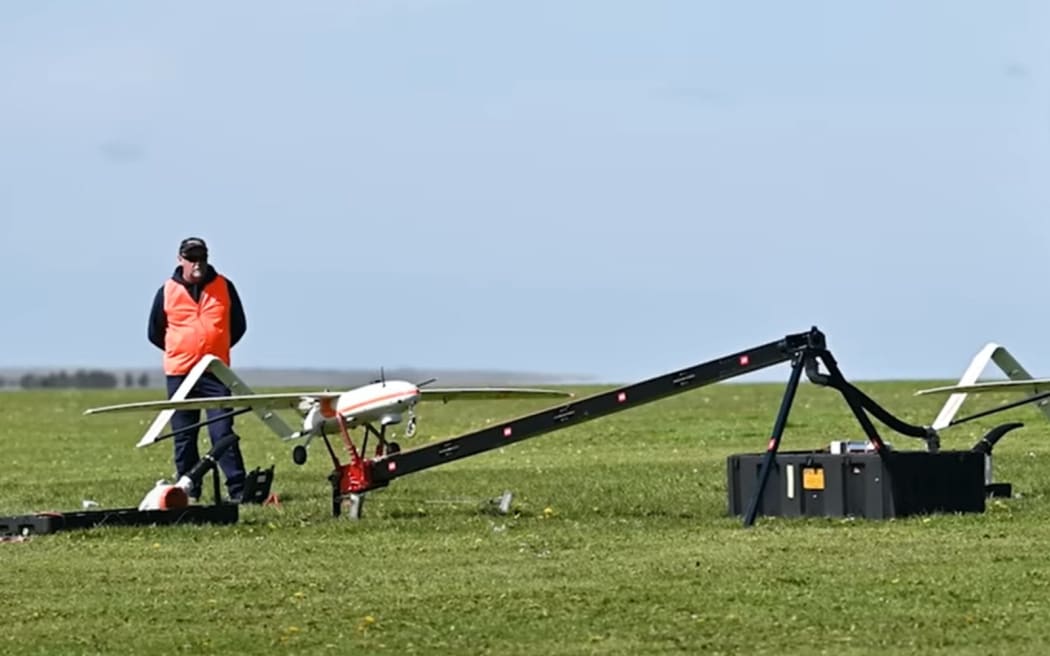New Zealand is hedging over a new US strategy to unleash thousands of battlefield drones to counter China, dubbed "hellscape" and "replicator".
The US has also begun experiments with swarms of drones with Australia and the UK in the AUKUS military alliance.

The government here says more drones are in the mix - not autonomous weapon systems, it said on Thursday - but not how far it might go with its partners.
"The Americans might suddenly drag all of us forward," Australian defence analyst Peter Layton, visiting fellow at the Griffith Asia Institute, said.
New Zealand earlier this year was asked to look at joining a subset of AUKUS that works on military technology, called Pillar Two, but the government on Thursday said: "Presently it is not clear what it would mean to be involved."
The headlines announcing a ground shift in US military strategy in the Indo-Pacific sound like scifi: 'Hellscape: DOD [US Defence launches massive drone swarm program to counter China'] and 'US military plans to unleash thousands of autonomous war robots over next two years'.

A top American commander used Hellscape to describe drones picking out 1000 targets in 24 hours.
The US Deputy Secretary of Defense calls it the 'Replicator' strategy, putting "multiple thousands" of drones in "multiple domains" within the next 18-24 months. Big, costly systems are out; "small, smart, cheap, and many" systems are in.
"This is a major change in military affairs," Layton told RNZ. "The Americans are focusing on the Indo-Pacific region, and so these autonomous systems will be used here first."
The US is all-in. And the UK, fresh from testing AI-enabled drone swarms to detect and track military targets, said it was "rapidly driving these technologies into responsible military use".
By virtue of those two being entwined with Australia in the new three-nation AUKUS, that tugs in Canberra, too.
"The worry about arms racing in relation to autonomous weapons technologies is real," said Jeremy Moses, associate professor of political science at Canterbury.
"China and the United States are both pursuing them quite relentlessly. So is Australia, and I think that's the biggest concern for New Zealand, is how heavily invested Australia is in the pursuit of autonomous technologies."
It sounds lethal. But Defence Minister Andrew Little drew a distinction: "User-operated drones and autonomous military systems are not the same thing," he told RNZ in a statement on Thursday.
New Zealand had advocated for binding international limits on autonomous weapons systems, and this position was reiterated last night by the Ministry of Foreign Affairs and Trade (MFAT).
However, the Cabinet paper it is based on dates from 2021, and was the one Little's office referred RNZ to yesterday.
Moses said since then, the government's position had become much more "murky", while at the same time it was very clear the Cabinet, and New Zealand Defence Force (NZDF), were intent on maintaining interoperability with the AUKUS trio.
"All of those countries have and are continuing to invest heavily in these types of technologies," Moses said.
"And it's not entirely clear what that will mean for the future interoperability of our armed forces with those countries. So I think there needs to be more open comment on where New Zealand stands on this."
RNZ asked Disarmament Minister Nanaia Mahuta about where New Zealand now stood on military drones. She was not available, and MFAT instead put out a statement saying engagement with partners "on a wide range of defence and security capability and interoperability matters - this is an integral part of New Zealand's national security".
"We advocate for international, legally binding rules and limits on autonomous weapons systems."
The US has promised to keep any killer robots - as opposed to surveillance ones - on a human leash, as happens now with Predator drones over Afghanistan.
Layton said in the first war fought with robots, in Ukraine - where an estimated 10,000 drones are being lost per month - drones were primarily used for surveillance.
"In the Ukraine it looks at the moment as though these systems are making the defence work much, much better. So for nations which are defensive, I think this is a good move."
Layton, who got a US public service medal for his work with the Pentagon, added surveillance drones could be fitted with bombs, though some could not carry much weight.
The AUKUS "world-first" experiment stressed how much faster the robot-drones could make any response - defensive or offensive.
"AI and autonomy represent that technological edge in a way that is going to really enhance our warfighting capability as a trinational coalition," a British commander said in a promo video.
The video showed drones 'talking' to armed Predator-type drones, tanks and big autonomous guns, and its AI learning in-flight. It was a big moment for Pillar Two technology-sharing.
Little said about that alliance: "New Zealand will continue to look for opportunities to work with partners to develop and enhance the technology that underpins our military capability in a way that is consistent with our values.
"We have good engagement across a range of defence and security matters with partners in the region, including the US and the Pacific Island Forum members.
"Our position on autonomous weapons systems is well understood, and we control what happens in our own air space. Other countries' decisions about their defence capability needs are a matter for them."

But what about drones with pilots on the ground, unarmed but scanning for targets to attack? That is less clear.
The NZ Defence Force would not say if it went along to the AUKUS drone swarm trial in the UK to have a look. It has bought about 100 drones since 2017. It told RNZ it had no plans to buy more, however:
"Experimentation with regard to these capabilities and consultation with our partner nations is ongoing. This is a very fast-moving technological market with rapid developments."
It may soon have such plans, as a new capability plan that covers the next 15 years was being finalised.
"It is to be expected that continued use of user operated drones will be part of the mix," Little said.
The work on a 15-year shopping list follows the release last month of a new defence strategy, which was silent on robot wars, though Little has pledged to build a more "combat capable" defence.
The US strategy showed it believed being combat-ready required drone armies.
Layton said Australia's military strategy had not kept pace with drones either.
"In Australia, the recent defence strategic review didn't really look at what was happening in the Ukraine war at all, and didn't really look into the future. We're somewhat future blind."
One plus of drones was they were cheaper than a lot of other enormously costly weapon systems, so could ease budget pressure on governments, Layton said. That was an expressed part of the US strategy.
Commentators, however, have pointed out it could get tricky trying to counter China's military with drones, when they rely on parts largely - for now - made in China.


